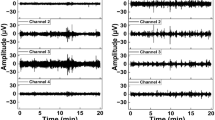Abstract
Abdominal uterine electromyograms (uEMG) studies have focused on uterine contractions to describe the evolution of uterine activity and preterm birth (PTB) prediction. Stationary, non-contracting uEMG has not been studied. The aim of the study was to investigate the recurring patterns in stationary uEMG, their relationship with gestation age and PTB, and PTB predictivity. A public database of 300 (38 PTB) three-channel (S1–S3) uEMG recordings of 30 min, collected between 22 and 35 weeks’ gestation, was used. Motion and labour contraction-free intervals in uEMG were identified as 5-min weak-sense stationarity intervals in 268 (34 PTB) recordings. Sample entropy (SampEn), percentage recurrence (PR), percentage determinism (PD), entropy (ER), and maximum length (L MAX) of recurrence were calculated and analysed according to the time to delivery and PTB. Random time series were generated by random shuffle (RS) of actual data. Recurrence was present in actual data (p < 0.001) but not RS. In S3, PR (p < 0.005), PD (p < 0.01), ER (p < 0.005), and L MAX (p < 0.05) were higher, and SampEn lower (p < 0.005) in PTB. Recurrence indices increased (all p < 0.001) and SampEn decreased (p < 0.01) with decreasing time to delivery, suggesting increasingly regular and recurring patterns with gestation progression. All indices predicted PTB with AUC ≥0.62 (p < 0.05). Recurring patterns in stationary non-contracting uEMG were associated with time to delivery but were relatively poor predictors of PTB.



Similar content being viewed by others
References
Censi F, Barbaro V, Bartolini P, Calcagnini G, Michelucci A, Gensini GF, Cerutti S (2000) Recurrent patterns of atrial depolarization during atrial fibrillation assessed by recurrence plot quantification. Ann Biomed Eng 28:61–70
Devedeux D, Marque C, Mansour S, Germain G, Duchêne J (1993) Uterine electromyography: a critical review. Am J Obstet Gynecol 169:1636–1653
Eckmann JP, Kamphorst SO, Ruelle D (1987) Recurrence plots of dynamical systems. Europhys Lett 4:973–977
Fele-Žorž G, Kavšek G, Novak-Antolič Ž, Jager F (2008) A comparison of various linear and non-linear signal processing techniques to separate uterine EMG records of term and pre-term delivery groups. Med Biol Eng Comput 46:911–922
Garfield RE, Saade G, Buhimschi C, Buhimschi I, Shi L, Shi SQ, Chwalisz K (1998) Control and assessment of the uterus and cervix during pregnancy and labour. Hum Reprod Update 4:673–695
Garfield RE, Maner WL, MacKay LB, Schlembach D, Saade GR (2005) Comparing uterine electromyography activity of antepartum patients versus term labor patients. Am J Obstet Gynecol 193:23–29
Goldberger AL, Amaral LAN, Glass L, Hausdorff JM, Ivanov PCh, Mark RG, Mietus JE, Moody GB, Peng CK, Stanley HE (2000) PhysioBank, PhysioToolkit, and PhysioNet: components of a new research resource for complex physiologic signals. Circulation 101:e215–e220
Grgic O, Matijevic R, Kuna K (2012) Raised electrical uterine activity and shortened cervical length could predict preterm delivery in a low-risk population. Arch Gynecol Obstet 285:31–35
Hassan M, Alexandersson A, Terrien J, Muszynski C, Marque C, Karlsson B (2013) Better pregnancy monitoring using nonlinear propagation analysis of external uterine electromyography. IEEE Trans Biomed Eng 60:1160–1166
Hassan M, Terrien J, Marque C, Karlsson B (2011) Comparison between approximate entropy, correntropy and time reversibility: application to uterine electromyogram signals. Med Eng Phys 33:980–986
Hausdorff JM (2009) Gait dynamics in Parkinson’s disease: common and distinct behavior among stride length, gait variability, and fractal-like scaling. Chaos 19:026113
Kennel MB, Brown R, Abarbanel HD (1992) Determining embedding dimension for phase-space reconstruction using a geometrical construction. Phys Rev A 45:3403–3411
Lucovnik M, Maner WL, Chambliss LR, Blumrick R, Balducci J, Novak-Antolic Z, Garfield RE (2011) Noninvasive uterine electromyography for prediction of preterm delivery. Am J Obstet Gynecol 204(228):e1–e10
Magagnin V, Bassani T, Bari V, Turiel M, Maestri R, Pinna GD, Porta A (2011) Non-stationarities significantly distort short-term spectral, symbolic and entropy heart rate variability indices. Physiol Meas 32:1775–1786
Maner WL, Garfield RE, Maul H, Olson G, Saade G (2003) Predicting term and pre-term delivery with transabdominal uterine electromyography. Obstet Gynecol 101:1254–1260
Marque C, Duchene JM, Leclercq S, Panczer GS, Chaumont J (1986) Uterine EHG processing for obstetrical monitoring. IEEE Trans Biomed Eng 33:1182–1187
Marque CK, Terrien J, Rihana S, Germain G (2007) Preterm labour detection by use of a biophysical marker: the uterine electrical activity. BMC Pregnancy Childbirth 7(Suppl 1):S5
Mohebbi M, Ghassemian H (2011) Prediction of paroxysmal atrial fibrillation using recurrence plot-based features of the RR-interval signal. Physiol Meas 32:1147–1162
Most O, Langer O, Kerner R, David GB, Calderon I (2008) Can myometrial electrical activity identify patients in preterm labor? Am J Obstet Gynecol 199(378):e1–e6
Porta A, D’Addio G, Guzzetti S, Lucini D, Pagani M (2004) Testing the presence of non stationarities in short heart rate variability series. Comp Cardiol 31:645–648
Rabotti C, Mischi M, Oei SG, Bergmans JW (2010) Noninvasive estimation of the electrohysterographic action-potential conduction velocity. IEEE Trans Biomed Eng 57:2178–2187
Verdenik I, Pajntar M, Leskosek B (2001) Uterine electrical activity as predictor of pre-term birth in women with pre-term contractions. Eur J Obstet Gynecol Reprod Biol 95:149–153
Webber CL Jr (2012) Recurrence quantification of fractal structures. Front Physiol 3:382
Webber CL Jr, Zbilut JP (1994) Dynamical assessment of physiological systems and states using recurrence plot strategies. J Appl Physiol 76:965–973
Acknowledgments
PL is funded by the National Institute for Health Research Newcastle Biomedical Research Centre based at Newcastle Hospitals Foundation Trust and Newcastle University. CM is supported by Research Capacity Funding from Newcastle upon Tyne NHS Foundation Trust. WT is funded by a Medical Research Council Bioinformatics Training Fellowship (Grant No. G902091).
Author information
Authors and Affiliations
Corresponding author
Rights and permissions
About this article
Cite this article
Di Marco, L.Y., Di Maria, C., Tong, WC. et al. Recurring patterns in stationary intervals of abdominal uterine electromyograms during gestation. Med Biol Eng Comput 52, 707–716 (2014). https://doi.org/10.1007/s11517-014-1174-6
Received:
Accepted:
Published:
Issue Date:
DOI: https://doi.org/10.1007/s11517-014-1174-6




